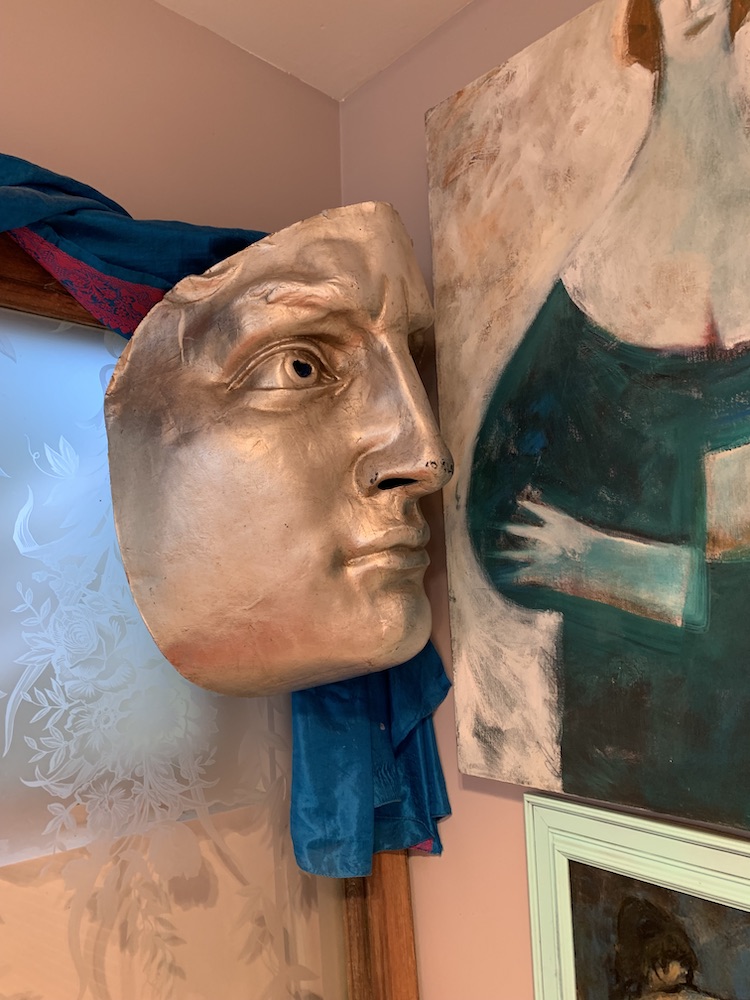The Face of David

I have clever readers who connect material objects with present day symbolism: FR asks, “What do I really see when I see a mask on a face?” Apropos to our past three years, she was compelled to rethink her huge three-foot Venetian papier-mâché mask of the face of Michelangelo’s David. She mentions seeing her attractively shaped neighbor, masked, as a stranger in 2021. She automatically overestimated his good looks – when the mask came off, he was a slight disappointment. Perceptual processing of the full face of a masked person is called amodal completion: COVID was an experience in facial perception. Humans see faces holistically from the eyes down to the chin (top down: termed ‘face pareidolia’) and if we don’t see a feature, we complete it. She references Douglas R Hofstadter’s I am a Strange Loop (2007), describing her own feedback loop around her ability to recreate a masked face; her neighbor was perceived, when masked, as beautiful as David.
We have all known that phenomenon, and had to sneak an astounded second look once a mask came off a face, right? Arguably the most beautiful face in art history, her David mask focused her attention on the phenomenon of “over-beautifying” an average face when masked. David masks were worn during the Pandemic (David was the monster slayer, but he is also a symbol of male beauty – in all his parts).
One day there will be a museum of masks worn during the lockdown, and I predict this museum will include virtual masks. An app developed in 2019 by MIT IBM’s Watson AI ‘learned’ 45,000 Renaissance paintings to compare to YOUR face, creating a virtual mask. AI-generated data gives us a whole new version of ‘the mask’, using personal photos “transmuted” to resemble portraits painted in the style of 15th century Old Masters like Titian and Rembrandt. Caveat: few Renaissance artists painted smiling people, so don’t expect an AI smile! Another app analyzes your face and compares it to historically painted portraiture to present you with your historical art doppelganger. And David himself has a doppelganger; in Florence you will see two Davids. The original is in the Accademia Gallery where it was moved in 1910 from the outdoor Piazza della Signoria; a copy was made for the Piazza del Duomo.
This mask of David, once worn to the Venice Carnival, is emblematic of the ever-mysterious mask. The noble face of David had been superimposed on various COVID masks throughout the world. One can put an image on one’s face of something symbolic, and that image “connects” immediately, unlike our faulty, overinflated analysis of HALF a face under a N95 mask. All the world knows David, an icon across cultures. A full-sized image of David was displayed at Dubai Expo in 2021, leading to decisions regarding nudity. Presenters had crafted an exquisite resin replica at scale, using laser scans and 3D printing covering the 15-foot work with marble dust. To display it, they imagined it viewed by the public inside of its shipping container, a glass 18-foot crate with pillars of support strategically placed for “protection” across the groin. I wonder what Michelangelo would have thought.
Two of the greatest artists of all time competed to bring David’s beauty to life: the five-ton stone from which David was carved was brought to Florence across the Mediterranean in the 15th century. The huge block of marble had such great promise that notable sculptors attempted a creation but failed. The stone languished into the 16th century when a competition was held between three sculptors, two of whom were Leonardo da Vinci and Michelangelo. Michelangelo won the commission for the sculpture in the Duomo, ‘making’ David from 1501-1504 – and we see David’s face 520 years later on COVID masks! Since the Greek era, masks have been an element of public performance, as we see they were integral to our public performance during our COVID years.
FP’s Venetian mask was worn on the top of the head at Carnival, made of papier-mâché over a resin support. Papier-mâché artists have made masks for the Commedia dell’arte since the 16th century. The faces were fantastic; we would have seen the Punchinello trickster, the miser, and the desirable maiden. Masks became identified with personality types, just as in our facial recognition software today.
To see, but not see, a masked face has ancient ramifications. Some masks are about disguise, some are about health, and some are about fun. But all are about what the face is and is NOT. This mask is valued at $500.







You must be logged in to post a comment.